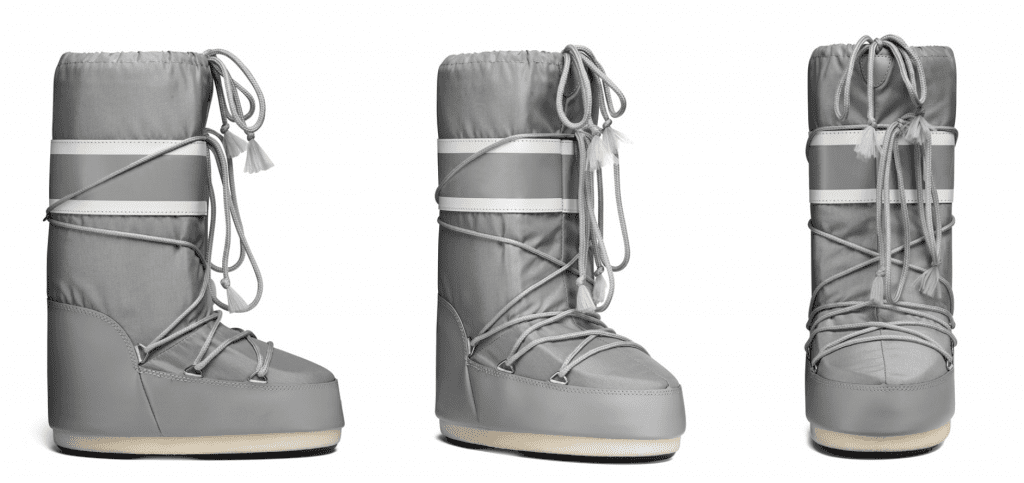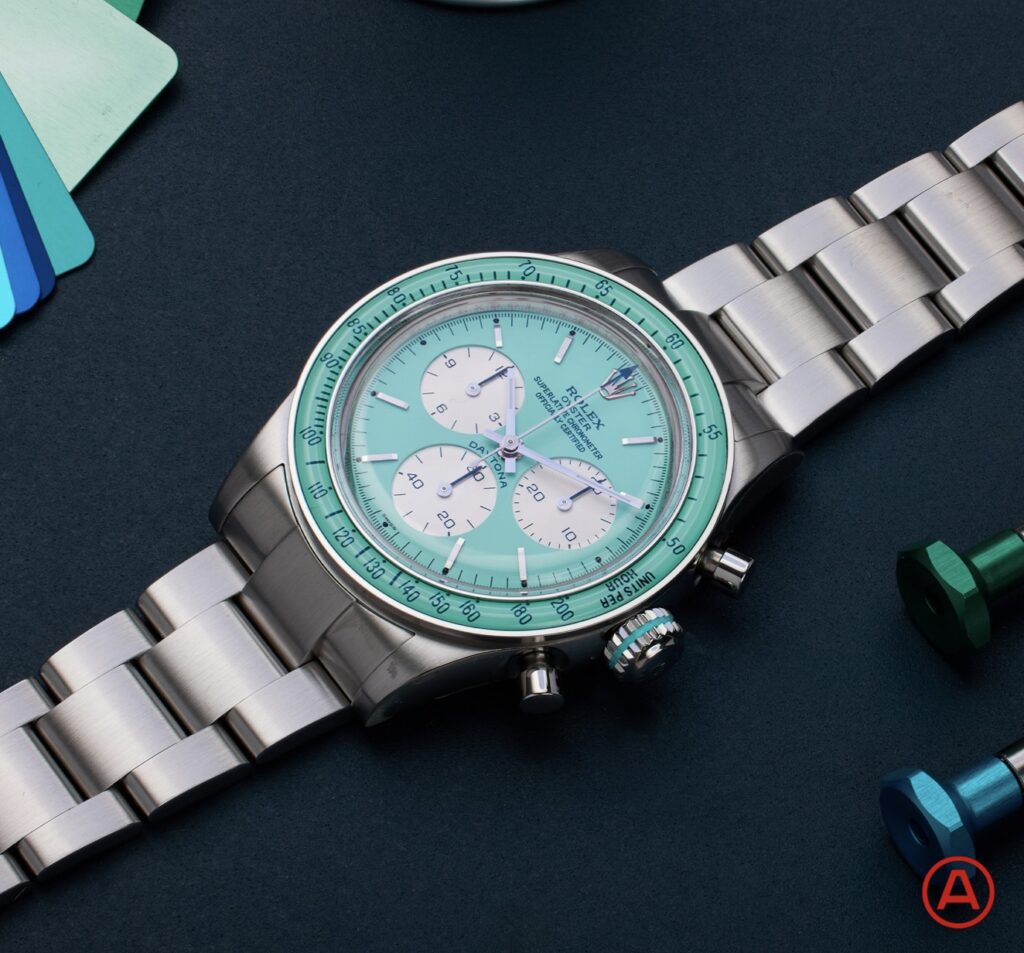Moon Boot-maker Tecnica Group has suffered another loss in its years-long quest to defend the registration of its famed footwear, with the European Union General Court upholding a previous finding that the three dimensional mark lacks the necessary distinctiveness to avoid invalidation. The case got its start on the heels of Swiss wholesaler Zeitneu GmbH lodging a declaratory judgment action with the Tribunale di Venezia, unsuccessfully seeking a declaration from the court that it was not infringing Tecnica’s Moon Boot trademark registration, and then initiating proceedings before the European Union Intellectual Property Office (“EUIPO”) to invalidate Tecnica’s boot mark.
In its 2017 opposition, Zeitneu argued that Tecnica’s trademark registration – which covers the configuration of an elliptical-shaped sole, L-shaped body, lacing that is “fastened in ring loops that move up the upper, crossing over at the back of the boot, finishing at the top of the boot shaft,” and “a central band [on the upper] that is wider and located between two external bands which are narrower” for use on leather goods, clothing, and footwear, among other things – is not distinctive, as required for trademark registration.
Given that the overall shape and design of Tecnica’s Moon Boot is not all that different from other après-ski boots on the market, Zeitneu asserted that consumers no longer view the design configuration as an indicator of source, and instead, view it as a generic style of boot.
And the EUIPO’s Cancellation Division agreed to an extent, declaring in a decision in March 2019 that the contested Moon Boot trademark is invalid with respect to footwear but not the other types of goods, stating that the boot design lacks distinctiveness in large part because the “L” shape mirrors that of a larger pool of boots, and therefore, cannot be registered in accordance with EU trademark law, which mandates that marks that are devoid of distinctive character shall not be subject to registration. With that in mind, the Cancellation Division invalidated the mark for use in Class 25, the class of goods/services that includes footwear.

Tecnica appealed, only to have the First Board of Appeal of the EUIPO uphold the Cancellation Division’s decision on the grounds that the moon boot mark “has the general ‘L’ shape of any other boot that has to adapt to the feet,” and therefore, “does not depart from the ‘norms or customs of the sector.’” In a decision in May 2020, the Board determined that the relevant public (i.e., consumers in all the Member States that display an average level of attention) would likely not view the 3D Moon Boot mark to “depart very significantly from the mass of after-ski boots” on the market, and thus, concluded that the contested mark was devoid of any distinctive character.
Among other things, Tecnica argued on appeal that evidence submitted by Zeitneu did not prove that consumers “had become used to the shape in question” and that, as a result, it “was devoid of any distinctive character.” On this front, the Appeal Board determined that it is “apparent from settled case-law that the distinctive character of a trademark … means that the mark in question makes it possible to identify the goods in respect of which registration is applied for as coming from a particular [entity], and thus, to distinguish those goods from those of other[s].” Beyond that, the trademark board held that precedent mandates that “the distinctive character of a mark be assessed, first, by reference to the goods or services in respect of which registration has been applied for and, secondly, by reference to the relevant public’s perception of the mark.”
While the Board asserted that the criteria for assessing the distinctive character of 3D trademarks consisting of the appearance of the product itself is no different from those applicable to other categories of trademarks, it noted that “average consumers are not in the habit of making assumptions about the origin of goods on the basis of their shape or the shape of their packaging in the absence of any graphic or word element, and it could prove more difficult to establish distinctive character in relation to such a three-dimensional mark than in relation to a word or figurative mark.”
Against this background, it held that “only a three-dimensional mark, consisting of the appearance of the product itself, which departs significantly from the norm or customs of the sector, and thereby, fulfils its essential function of indicating origin [and] is not devoid of any distinctive character for the purposes of Article 7(1)(b).”
On the heels of the First Board of Appeal upholding the partial invalidation of the Moot Boot mark, Tecnica appealed again – this time to the European Union’s General Court, which sided with Zeitneu. Dismissing the appeal in its entirety, the General Court held that “the shape of the contested mark corresponds to the common shape of after-ski boots, which generally consist of a high shaft, often in a light synthetic material, with soles and laces,” and thus, while the boots, themselves, may be iconic, the shape is devoid of the necessary distinctive character to function as a trademark.
Reflecting on the General Court’s decision, Eleonora Rosati, the Director of the Institute for Intellectual Property and Market Law at Stockholm University, says that it brings us “back to (a non-distinctive) reality” in the wake of a decision over the shape of a Guerlain lipstick case. This summer, the European Union’s General Court handed LVMH-owned Guerlain a win, overturning earlier determinations of the EUIPO and its Board of Appeal, both of which refused to register the shape of the French cosmetics and perfume brand’s lipstick case on the basis that the design of the three-dimensional packaging does not “depart significantly” from what others in the beauty segment of the market are doing, and thus, does not have the distinctive character necessary to serve as a trademark.
In a decision dated July 14, the General Court held that the shape of Guerlain’s Rouge G lipstick packaging “satisfied the significant departure test and could be, therefore, registered,” a decision that Rosati says “offered some hope for those seeking to register less conventional signs.”
The court’s decision in the case at hand, however, comes in contrast to that prior determination.
Another interesting aspect of the running battle over the Moon Boot trademark, according to Rosati, is that “while the trademark registration has been regarded as partly invalid, Italian courts have, on different occasions (including in the context of previous decisions from the courts of Venice in Italy), found that the iconic after ski footwear is deserving of copyright protection.” Most recently, Rosati asserts that “this is what the Milan Court of First Instance held in a copyright infringement case that was decided nearly a year ago, in the case that Tecnica successfully waged against the maker of Chiara Ferragni-branded after-ski boots.”
In any case, Rosati notes, “the requirements for trademark registration and copyright are – and remain – obviously distinct, and last week’s decision from the General Court also provides an indirect reminder of this.”














